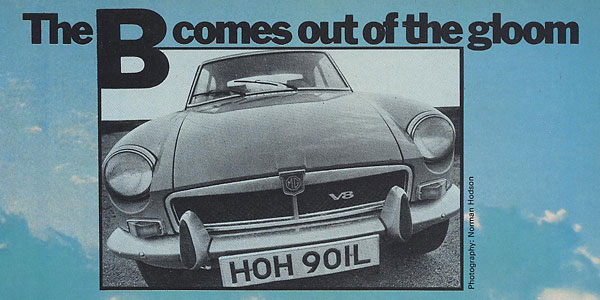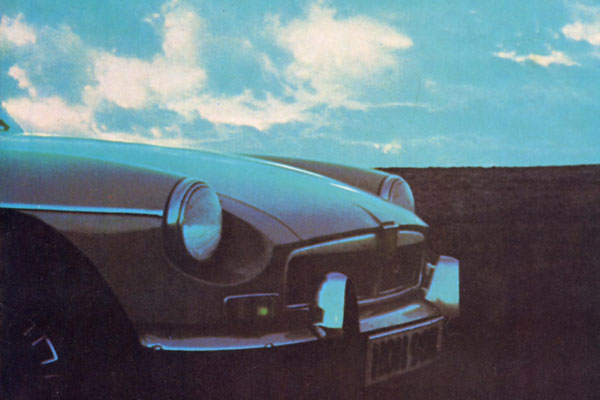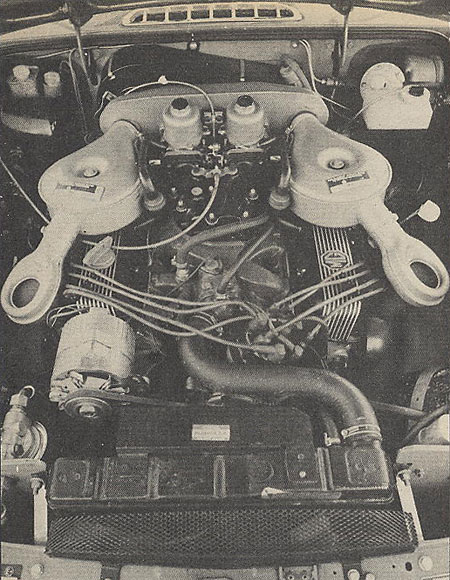
The B Comes Out of the Gloom
as published in BritishV8 Magazine, Volume XVI Issue 2, October 2008
Re-printed unedited by exclusive permission of "Cars and Car Conversions".
This article originally appeared in their issue for February 1974.
by: Fred Game
photos by: Norman Hodson
The trouble with the MGB is that time ran out for it some years back. Nice looking
car, good and solid, dependable, value for money and really quite economical. But
in no way a sports car. The rot set in during the late sixties when saloon cars
started to go quickly and even went round corners without too much of the wrong
kind of dramatics. Now we've reached the stupid situation where almost any two
litre family hack is quicker than the 1.8 litre MG. Hardly a prospect to encourage
sales for a sports car bearing the famous octagon badge.
A morale booster was needed, and drivers cried out for more power. What about the
V8 Rover engine, they said, and the most enterprising Ken Costello even set up a
small production line producing his own V8 B's. But no word from sleepy Abingdon
where MG's have been made since the old days of sidescreens and wire wheels. Then
it came. This summer the MGB GT V8 was announced by British Leyland. Closed version
only, very limited production, and not for export - not even to the sports car
demanding U.S. market. Externally exactly the same as the smaller engined model
(which continues in production) but a very different motor under the bonnet. No
likely disaster like the ill-fated MGC, but a flagship for the fleet, the performance
of which promises to keep the MG name up in the front row of the fast car grid and
also a car which in no doubt will in its own way encourage sales of the lower
powered version.
But is it enough? Should the V8 have had a new body, or is this just an interim move?
How does it go? Is it the 240Z beater it looks? And what does a former 1.8 B owner
think of it? Fred Game (who says his car was bored to 2.1 litres anyway) investigates
overleaf.
MGB GT V8 is one hell of a mouthful, in fact it's likely to give you cramp
in your vocals if you try and say it too quickly. In this day and age of type number
model classification, where the top prestige car in the performance range from one
of our major manufacturers is given a top-heavy suffix, such as "Super de Luxe GT
Special Le Mans Superleggerra S-type GXL Monza Tiiiiii Fastback Mk.Ill" it's almost
acceptable, or is it?
When the MGA became an MGB, there was good reason, like a different shell and a bigger
engine. The origins of the 'C' undermined the principle a little as the only changes
were the installation of a seven-bearing lorry engine and Morry Minor front suspension.
These revolutionary changes did not alter the basic characteristics of the 'B' to any
extent. It still understeered chronically in the wet and despite the extra power the
big mill was just not responsive enough to encourage anything other than leisurely
driving, at least not safely. Putting the V8 in made the car totally different, a
quick touch of the proverbial chalk and cheese syndrome, would you believe, definitely
a case for a new letter. But no, good old BLMC forgot that the 'C' ever existed, stuck
with the 'B' suffix (which would have been logical if the MGC never had made the
production line) and stuck in the V8 qualification.
Which is all a bit of a downer, 'cos as I said, it's a different animal altogether -
providing you forget things like the rather antiquated interior, seating position and
haphazardly situated controls.

However, more of the personal impressions bit anon; now's the time for a quick delve into the mechanical complexity of the thing. Having been shown the way to install the Rover V8 into a 'B' shell by Ken Costello (who still makes them himself by the way, down in Farnborough, Kent) the design staff at BLMC could have been forgiven for merely copying Ken's methods completely. But they didn't. Rather than use the 'B' gearbox and drive train, they opted for the C-type components, with a few mods thrown in for good measure. For starters, the casing itself was redesigned so that a larger clutch - mit ballrace release bearing instead of the more normal carbon thrust - could be incorporated, whilst the insides also came in for a bit of attention, with stronger and higher intermediate ratios to make full use of the extra torque available, Of course, all forward gears have the modern luxury of synchromesh and the standard fitting overdrive operates on top only. The 'C' rear axle pulls a 3.91 to 1 crownwheel and pinion, rather than the 'little' version's 3.07 to 1.

Suspension is as per the normal 'B' with coil springs and unequal length wishbones
at the front and half elliptic leaf springs at the rear, although they are uprated
to cope with the extra power. Brakes retain the time honoured disc/drum layout and
have a servo fitted as standard equipment to help the leg muscles a bit. Actual
dimensions for these all important goodies are 10.7 inches diameter for the discs
and 10 inches diameter for the drums. The very attractive wheels are manufactured
by Dunlop on their composite principle ie, alloy centres with steel rims and carry
175 x 14 tyres.
Engine power output is a resounding 137 bhp (well, that's pretty resounding when you
consider it in relation to the 1.8 litre's efforts) developed at 5000 rpm. The torque
figure is more impressive at 193 lb ft at a leisurely 2900, but then there are 3528
good reasons why it should be that high. They're the number of cc's, twit! Main mods
to the unit itself, primarily to get it to fit under the bonnet without the need for
MGC type unsightly bulges, centre around a swept-back manifold to take the twin HIF 6
SU carbies rather than the old penthouse shaped (how nice!) effort used on the Rovers.
In appearance - if nothing else - this manifold resembles the one that Mr Costello
uses to mount a 45 DCOE Weber on, that could be one way of getting back some of the
original Rover 3500 'S's 184 bhp that used to be developed before detuning and the
fitting of even more horrible anti-tox stuff. Still, my 600 odd test miles did return
what I considered to be a fair fuel consumption of 19.5 miles per gallon. But what of
the actual performance figures, like what do you get in terms of velocity out of the
extra availability of neddies? From parked to 60 mph (you do remember 60 mph don't you?)
takes just on 8 seconds, which is 3 secs quicker than the four-banger, whilst the top
speed climbs from 210% of the present overall speed limit to 251% in mph that's 105
to 125.5.
Enjoying this article? Our magazine is funded through the generous support of readers like you!
To contribute to our operating budget, please click here and follow the instructions.
(Suggested contribution is twenty bucks per year. Feel free to give more!)
Moving on to the body, it's really just a case of "you've seen it all before", but for
the wheels and Rover V8 badges there is no noticeable difference between the 3.5 and
1.8 litre unless you look for the little notes of subtleness like the tinted glass and
the door mounted mirrors.
Inside, the subtle change note is continued, with comfortable, cloth covered seats
that unfortunately offer little in the way of side support, smaller speedo and rev
counter to allow for the larger shroud that covers the energy absorbing steering column
and the switchgear that now resides in that area, and a horrible leather-rim steering
wheel without holes in the spokes that is a true study in grotness. Why is it that MGA's,
B's and C's always have awful steering wheels fitted as standard? Don't the designers
ever use the results of their artistry to point a car? Perhaps they're all wizards at
the handbrake art, a factor which I don't believe as the one in my test car (and the
one in the 'B' that I owned) was so effective that it might as well have been left out.

Once I started to drive the car, most of the inherent faults could be forgotten,
despite the unfriendly comments made previously. Really. I like the 'B', otherwise
I wouldn't have bought one a couple of years ago, would I? In 1.8 litre form, an
MGB is a smooth, fast touring two-seater, capable of covering large distances at
high average speeds without reducing the driver to a quivering, overtired zombie.
With the V8 urge the plus points remain, and in addition there is enough acceleration
to outdrag most of the saloons that find it easy to pee over the 4-cylinder device,
a factor that might not sound important, but one that I used to find personally
nauseating.
But the noise! My own car was a 1.8 convertible, and I expected it to be bad as far
as wind noise was concerned. I was therefore pleased that mine didn't suffer very
much from flapping leathercloth and rattling hood stays. However, each time I
exceeded 60 mph with the GT (this was before the 50 limit) oh dear! No matter what
I did - opening the quarterlights, closing them, opening the windows, trying them
at different levels - nothing but nothing would lower the wind noise enough to be
able to hear the radio at anything less than full volume. I checked the door
alignment and the window fitting without finding any obvious faults, so I can only
assume that all 'B' GT's are bad in this respect.
Previous experience of 'B' brakes fitted with a servo taught me to respect them and
the V8 was no different. One prod on the appropriate pedal gives a genuine "shit,
I've hit a brick wall" effect,
Handling is really a case of what you make of it. The well chosen gear ratios, ample
power and good brakes all help to make entering and leaving corners a quicker and
simpler process than it has been with previous MG's, using the throttle pedal sensibly
also means that the understeering tendencies referred to earlier can be countered
which makes the car what you might loosely term as neutral (i.e. it will understeer
in and oversteer out of almost any sort of bend).
At £2293.96 the MGB GT V8 is not a cheap car, beating a 3-litre Capri by the best part
of £500, but then people don't buy 'B's as alternatives to Capris, do they?
BritishV8 Magazine has assembled the largest, most authoritative collection of MG "MGB GT V8" information you'll find anywhere. Check it out! Access our MGB GT V8 article index by clicking here.

